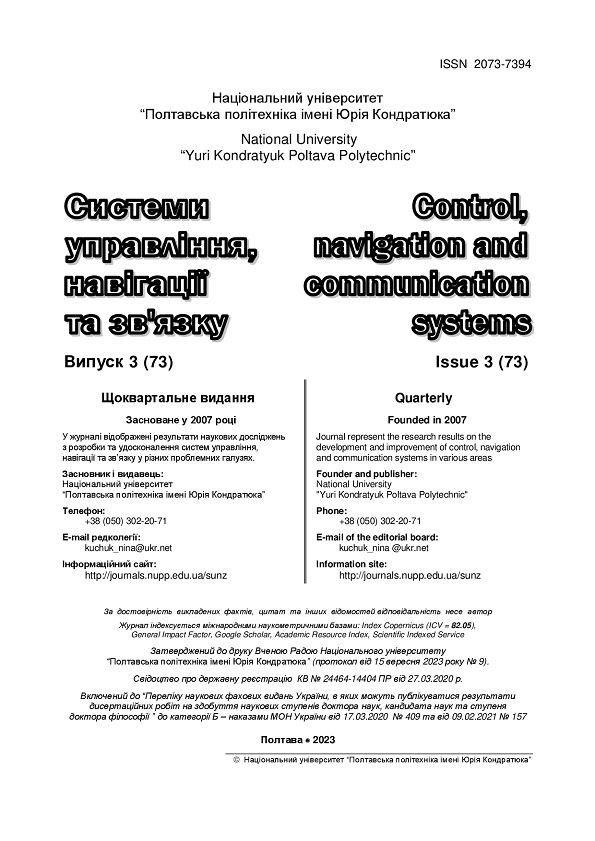MODELING THE RELIABILITY OF TRANSPORT UNDER EXTREME CONDITIONS OF OPERATION AS A QUEUING SYSTEM WITH PRIORITIES
DOI:
https://doi.org/10.26906/SUNZ.2023.3.010Keywords:
transport system, agent modeling, simulation modeling, queuing systems, absolute priority, arrival and service intensity, service and push-out probabilities, client service probabilitiesAbstract
The article presents a simulation model of a queuing system (QS) with a queue and relative priority, which can be used to manage the reliability of transport systems under resource constraints. The developed simulation model combines agent and discrete-event simulation principles and allows studying queuing systems in terms of establishing regularities: probabilities (service, failure, push-out), time delays (waiting in a queue, under service), queue sizes, order of queue formation upon arrival of clients of different priority. As a result of the research, dependencies were obtained for the probability of servicing higher priority clients depending on the intensities of their arrival and service; probabilities of servicing lower priority clients depending on the intensity of service and servicing of higher priority clients; the probability of "pushing out" lower priority clients from the QS by higher priority clients depending on service intensities and the arrival of high priority clients.Downloads
References
I. Makushenko, I. Usar, H. Livinska, and M. Sharapov, “Optimal threshold strategies for retrial systems with queue,” J. Comput. Appl. Math., vol. 427, p. 115136, Aug. 2023, doi: 10.1016/J.CAM.2023.115136.
A. Aghsami, S. R. Abazari, A. Bakhshi, M. A. Yazdani, S. Jolai, and F. Jolai, “A meta-heuristic optimization for a novel mathematical model for minimizing costs and maximizing donor satisfaction in blood supply chains with finite capacity queueing systems,” Healthc. Anal., vol. 3, p. 100136, Nov. 2023, doi: 10.1016/J.HEALTH.2023.100136.
H. Jahani, A. E. Chaleshtori, S. M. S. Khaksar, A. Aghaie, and J. B. Sheu, “COVID-19 vaccine distribution planning using a congested queuing system—A real case from Australia,” Transp. Res. Part E Logist. Transp. Rev., vol. 163, p. 102749, Jul. 2022, doi: 10.1016/J.TRE.2022.102749.
A. Mazaraki, V. Matsiuk, N. Ilchenko, O. Kavun-Moshkovska, and T. Grygorenko, “Development of a multimodal (railroadwater) chain of grain supply by the agent-based simulation method,” Eastern-European J. Enterp. Technol., vol. 6, no. 3 (108), pp. 14–22, Dec. 2020, doi: 10.15587/1729-4061.2020.220214.
K. Abdulaziz Alnowibet, A. Khireldin, M. Abdelawwad, and A. Wagdy Mohamed, “Airport terminal building capacity evaluation using queuing system,” Alexandria Eng. J., vol. 61, no. 12, pp. 10109–10118, Dec. 2022, doi:10.1016/J.AEJ.2022.03.055.
“Вычислительные системы с очередями — Леонард Клейнрок.” https://www.livelib.ru/book/1001277388-vychislitelnyesistemy-s-ocheredyami-leonard-klejnrok (accessed Mar. 03, 2023).
D. P. Bertsekas and R. G. Gallager, “Сети передачи данных,” p. 486, 1986, Accessed: Mar. 03, 2023. [Online]. Available:http://libarch.nmu.org.ua/handle/GenofondUA/60656.
“Управление моделью системы массового обслуживания с использованием динамических приоритетов - CORE Reader.” https://core.ac.uk/reader/80134930 (accessed Mar. 15, 2023).
V. Matsiuk, N. Ilchenko, O. Pryimuk, D. Kochubei, and A. Prokhorchenko, “Risk assessment of transport processes by agentbased simulation,” AIP Conf. Proc., vol. 2557, no. 1, p. 080003, Oct. 2022, doi: 10.1063/5.0105913.
V. Matsiuk, O. Galan, A. Prokhorchenko, and V. Tverdomed, “An Agent-Based Simulation for Optimizing the Parameters of a Railway Transport System.”
M. D. Katsman, V. K. Myronenko, V. I. Matsiuk, and P. V. Lapin, “Approach to determining the parameters of physical security units for a critical infrastructure facility,” Reliab. Theory Appl., vol. 16, no. 1, pp. 71–80, 2021, doi: 10.24412/1932-2321-2021-161-71-80.
M. D. Katsman, V. K. Myronenko, and V. I. Matsiuk, “Mathematical models of ecologically hazardous rail traffic accidents,” Reliab. Theory Appl., vol. 10, no. 1 (36), 2015, Accessed: Nov. 14, 2020. [Online]. Available:https://cyberleninka.ru/article/n/mathematical-models-of-ecologically-hazardous-rail-traffic-accidents.




